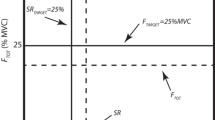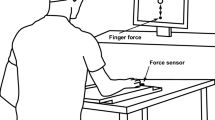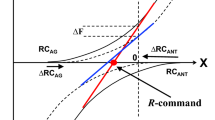Abstract
We explored unintentional changes in forces during performance of constant and cyclic force-production tasks (F-tasks) after visual feedback removal. Based on earlier studies, we expected all force parameters to drop exponentially with time. We also explored possible role of working memory in the force drop phenomena. Healthy subjects performed constant or cyclic isometric F-tasks with the index finger under visual feedback. The cyclic task was paced by a metronome. Removing visual feedback resulted in a consistent force drop in constant F-tasks and a qualitatively similar drift in the mean force in the cyclic F-task. Both were slow with characteristic times of about 10–20 s. In contrast, force amplitude in the cyclic F-task increased quickly (within 1–2 s). When the subjects were asked to stop producing force for 5 s after the visual feedback disappeared and then resume force production, no downward force drift was seen in constant F-tasks, while in cyclic F-tasks, the drift of the mean force was present and an exaggerated increase in force amplitude was also observed. We conclude that while working memory limitations may influence cyclic F-tasks, their role in determining the force drift in constant F-tasks is limited. The results of both experiments are interpreted within the referent configuration hypothesis supplemented with an idea of unintentional drift of referent coordinates (RC-back-coupling) induced by differences between the referent and actual body configurations.







Similar content being viewed by others
References
Ambike S, Paclet F, Zatsiorsky VM, Latash ML (2014) Factors affecting grip force: anatomy, mechanics, and referent configurations. Exp Brain Res 232:1219–1231
Ambike S, Zatsiorsky VM, Latash ML (2015) Processes underlying unintentional finger-force changes in the absence of visual feedback. Exp Brain Res 233:711–721
Corcos DM, Gottlieb GL, Latash ML, Almeida GL, Agarwal GC (1992) Electromechanical delay: an experimental artifact. J Electromyogr Kinesiol 2:59–68
Feldman AG (1966) Functional tuning of the nervous system with control of movement of maintenance of a steady posture—II Controllable parameters of the muscle. Biophysika 11:565–578
Feldman AG (1980) Superposition of motor programs—II. Rapid forearm flexion in man. Neuroscience 5:91–95
Feldman AG (1986) Once more for the equilibrium point hypothesis (λ model) for motor control. J Mot Behav 18:17–54
Feldman AG (2009) Origin and advances of the equilibrium-point hypothesis. Adv Exp Med Biol 629:637–643
Feldman AG (2011) Space and time in the context of equilibrium-point theory. Wiley Interdiscip Rev Cogn Sci 2:287–304
Feldman AG (2015) Referent control of action and perception. Challenging conventional theories in behavioral neuroscience. Springer, New York
Feldman AG, Levin MF (1995) Positional frames of reference in motor control: their origin and use. Behav Brain Sci 18:723–806
Gelfand IM, Latash ML (1998) On the problem of adequate language in motor control. Mot Control 2:306–313
Hogan N, Sternad D (2007) On rhythmic and discrete movements: reflections, definitions and implications for motor control. Exp Brain Res 181:13–30
Jo HJ, Ambike S, Lewis MM, Huang X, Latash ML (2015) Finger force changes in the absence of visual feedback in patients with Parkinson’s disease. Clin Neurophysiol. http://dx.doi.org/10.1016/j.clinph.2015.05.023
Latash ML (1994) Reconstruction of equilibrium trajectories and joint stiffness patterns during single-joint voluntary movements under different instructions. Biol Cybern 71:441–450
Latash ML (2010) Motor synergies and the equilibrium-point hypothesis. Mot Control 14:294–322
Latash ML (2012) The bliss (not the problem) of motor abundance (not redundancy). Exp Brain Res 217:1–5
Latash ML, Friedman J, Kim SW, Feldman AG, Zatsiorsky VM (2010) Prehension synergies and control with referent hand configurations. Exp Brain Res 202:213–229
Martin V, Scholz JP, Schöner G (2009) Redundancy, self-motion, and motor control. Neural Comput 21:1371–1414
Neely KA, Coombes SA, Planetta PJ, Vaillancourt DE (2013) Segregated and overlapping neural circuits exist for the production of static and dynamic precision grip force. Hum Brain Mapp 34:698–712
Park J, Pažin N, Friedman J, Zatsiorsky VM, Latash ML (2014) Mechanical properties of the human hand digits: age-related differences. Clin Biomech 29:129–137
Pilon J-F, De Serres SJ, Feldman AG (2007) Threshold position control of arm movement with anticipatory increase in grip force. Exp Brain Res 181:49–67
Reinkensmeyer DJ, Akoner O, Ferris DP, Gordon KE (2009) Slacking by the human motor system: computational models and implications for robotic orthosis. IEEE Eng Med Biol Soc 2009:2129–2132
Reschechtko S, Zatsiorsky VM, Latash ML (2014) Stability of multifinger action in different state spaces. J Neurophysiol 112:3209–3218
Sainburg RL (2002) Evidence for a dynamic-dominance hypothesis of handedness. Exp Brain Res 142:241–258
Scholz JP, Schöner G (1999) The uncontrolled manifold concept: identifying control variables for a functional task. Exp Brain Res 126:289–306
Schöner G (1990) A dynamic theory of coordination of discrete movement. Biol Cybern 63:257–270
Schoner G, Kelso JAS (1988) Dynamic pattern generation in behavioral and neural systems. Science 239:1513–1520
Shapkova EY, Shapkova AL, Goodman SR, Zatsiorsky VM, Latash ML (2008) Do synergies decrease force variability? a study of single-finger and multi-finger force production. Exp Brain Res 188:411–425
Singh T, Zatsiorsky VM, Latash ML (2012) Effects of fatigue on synergies in a hierarchical system. Hum Mov Sci 31:1379–1398
Slifkin AB, Vaillancourt DE, Newell KM (2000) Intermittency in the control of continuous force production. J Neurophysiol 84:1708–1718
Vaillancourt DE, Russell DM (2002) Temporal capacity of short-term visuomotor memory in continuous force production. Exp Brain Res 145:275–285
Vaillancourt DE, Slifkin AB, Newell KM (2001) Visual control of isometric force in Parkinson’s disease. Neurophysiologia 39:1410–1418
Wilhelm L, Zatsiorsky VM, Latash ML (2013) Equifinality and its violations in a redundant system: multi-finger accurate force production. J Neurophysiol 110:1965–1973
Zhou T, Solnik S, Wu Y-H, Latash ML (2014) Unintentional movements produced by back-coupling between the actual and referent body configurations: Violations of equifinality in multi-joint positional tasks. Exp Brain Res 232:3847–3859
Zhou T, Zhang L, Latash ML (2015) Intentional and unintentional multi-joint movements: their nature and structure of variance. Neuroscience 289:181–193
Acknowledgments
This work was sponsored in part by NIH Grants NS-035032 and AR-048563.
Author information
Authors and Affiliations
Corresponding author
Ethics declarations
Conflict of interest
None.
Rights and permissions
About this article
Cite this article
Ambike, S., Mattos, D., Zatsiorsky, V.M. et al. The nature of constant and cyclic force production: unintentional force-drift characteristics. Exp Brain Res 234, 197–208 (2016). https://doi.org/10.1007/s00221-015-4453-z
Received:
Accepted:
Published:
Issue Date:
DOI: https://doi.org/10.1007/s00221-015-4453-z




